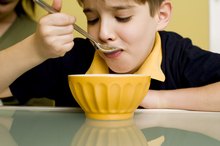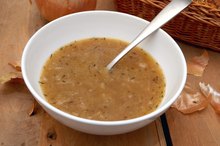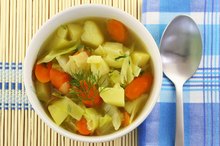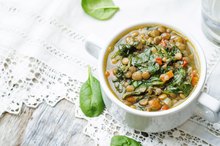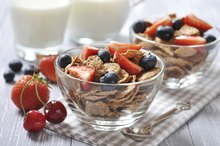Soup & Cereal Diet
The soup and cereal diet is also popularly known as the soup, cereal and salad diet. It features bowl-friendly foods that are low in calories to help you lose weight. Although the eating plan is not designed to be followed for more than a couple of weeks, it does present some risk of dietary imbalance and nutrient deficiencies.
Features
The soup and cereal diet works on the premise that the foods you normally eat in a day add up to a greater number of calories than soups, cereals and salads would. Thus, swapping out your normal menus for those foods may reduce daily calorie totals and result in gradual weight loss over the period during which you follow the diet.
Guidelines
How to Lose Weight With a Cereal Diet
Learn More
For the greatest nutritional success on the diet, it’s helpful to follow guidelines. Eat the greatest variety of fruits and vegetables you can. Add fresh fruit to cereal, eat it with salad or serve it as an accompaniment to soup; include vegetables in the soups you eat and make salads regularly. Choose low-calorie and low-fat options. Cream-based soups and sugary cereals offer little nutritional value and won’t help with weight loss. Supplement the diet with nutrients it doesn’t provide. For example, eat cereal with Greek yogurt instead of milk to get extra protein.
- For the greatest nutritional success on the diet, it’s helpful to follow guidelines.
- Cream-based soups and sugary cereals offer little nutritional value and won’t help with weight loss.
Menu
A sample menu for the soup and cereal diet is simple and it changes little from day to day. Breakfast is cereal of any type, hot or cold, with milk and fresh fruit. Lunch is soup, preferably low-fat and served with salad to provide more fresh vegetables. Dinner is either another bowl of soup or a large salad. Snacking on the diet is allowed. Potential snacks might be cereal bars, fresh fruit or vegetable pieces.
- A sample menu for the soup and cereal diet is simple and it changes little from day to day.
- Lunch is soup, preferably low-fat and served with salad to provide more fresh vegetables.
Considerations
Wheat Chex Cereal Nutrition Information
Learn More
Serving size and nutrient breakdown are two major considerations with the soup and cereal diet plan. Even if you make healthy, low-calorie choices in what you eat, you’re unlikely to lose weight if you dish out large portion sizes or make a habit of refilling your bowl for second or third helpings. Keep portions moderate for the best weight-loss results. Monitor the nutrients you’re getting. Soup, cereal and salad provide simple carbohydrates, salt and sugar, but little protein or healthy fat. The Mayo Clinic recommends that healthy adults get about 55 percent of daily calories from complex carbs, 25 percent from fat and 20 percent from lean protein.
- Serving size and nutrient breakdown are two major considerations with the soup and cereal diet plan.
- Even if you make healthy, low-calorie choices in what you eat, you’re unlikely to lose weight if you dish out large portion sizes or make a habit of refilling your bowl for second or third helpings.
Warning
Speak with your doctor before starting the soup and cereal diet or making any significant changes to your eating plan. On a long-term basis, the diet can result in nutrient deficiencies and related side effects, such as headaches and fatigue. According to the National Institutes of Health, the only safe and reliable method for lasting weight loss is regular exercise coupled with a balanced, low-calorie eating plan.
Related Articles
References
- Kuroda M, Ohta M, Okufuji T, et al. Frequency of soup intake is inversely associated with body mass index, waist circumference, and waist-to-hip ratio, but not with other metabolic risk factors in Japanese men. J Am Diet Assoc. 2011;111(1):137-42. doi:10.1016/j.jada.2010.10.004
- Zhu Y, Hollis JH. Soup consumption is associated with a reduced risk of overweight and obesity but not metabolic syndrome in US adults: NHANES 2003-2006. PLoS One. 2013;8(9):e75630. doi:10.1371/journal.pone.0075630
- Wright N, Wilson L, Smith M, Duncan B, Mchugh P. The BROAD study: A randomised controlled trial using a whole food plant-based diet in the community for obesity, ischaemic heart disease or diabetes. Nutr Diabetes. 2017;7(3):e256. doi:10.1038/nutd.2017.3
- Pan A, Hu F. Effects of carbohydrates on satiety: Differences between liquid and solid food. Curr Opin Clin Nutr Metab Care. 2011;14(4):385-390. doi:10.1097/mco.0b013e328346df36
Writer Bio
Carly Schuna is a Wisconsin-based professional writer, editor and copy editor/proofreader. She has worked with hundreds of pieces of fiction, nonfiction, children's literature, feature stories and corporate content. Her expertise on food, cooking, nutrition and fitness information comes from a Level 1 personal training certification and years of in-depth study.

